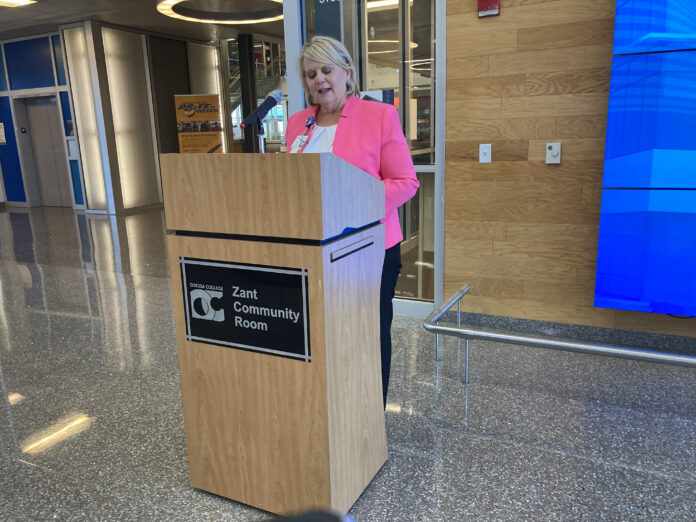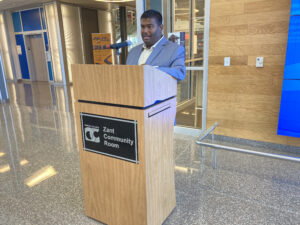
Amid much appreciation and thanks, it was announced Thursday that Odessa Regional Medical Center has committed $1 million to Odessa College’s new $40 million Wood Health Sciences Building. OC will name the third floor of the 83,000 square foot, four-story building the “Odessa Regional Medical Center Instruction Floor.”
The news conference was held in the lobby of the Saulsbury Campus Center at Odessa College and live-streamed on Facebook.
Executive Director of Advancement Jacqui Gore said the groundbreaking is expected to take place Sept. 1. The funds will be paid out to OC over the next 10 years, Gore said. The investment was revealed at the May 25 OC Board of Trustees meeting.
Gore said they will prominently display the Odessa Regional Medical Center, a Steward family hospital, logo right as visitors and students walk on to the third floor of the to-be-constructed building.
“The partnership also includes the opportunity for Odessa Regional Medical Center leadership to teach and mentor students taking classes in the Wood Health Sciences Building, preparing them to go right to work in hospitals, doctors’ offices, home health agencies and nursing homes in the Permian Basin,” Gore said.
The partnership with ORMC brings the college to 80 percent of its $40 million construction goal and closer to breaking ground on the building on Sept. 1, Gore said.
“The construction of the new Wood Health Sciences Building at Odessa College is critically important to the success of the healthcare community, not only in Odessa, but the entire Permian Basin,” Stacey Brown, president of Odessa Regional Medical Center and Scenic Mountain Medical Center in Big Spring, said in a news release. “This increased capacity is vital to helping medical providers care for our community, but it will also provide excellent jobs for young adults to be productive members of our community for years to come.”
Brown added that the facility is important to the region’s economic viability, as well.
“This larger facility will create additional teaching and support jobs at Odessa College in order for them to expand their programs with more students to fill … these critical needs within our community. There seems to always, and I do mean always, be a shortage of qualified medical personnel in nearly every discipline that you can imagine,” Brown said.
“With other major projects at play in our community such as Nacero, it is so important now more than ever that are we are taking action to grow our own healthcare professionals to meet the needs of our growing community,” Brown added.
The third floor will provide 20,500 square feet of learning space for the School of Health Sciences and will include nine classrooms, three computer labs, two study halls, a student lounge, a faculty lounge and faculty offices.

ORMC Chief Medical Officer Rohith Saravanan said fighting the coronavirus pandemic took a terrible toll on many people, especially healthcare workers.
“Reports show that some of them saw more death in the last year than in their entire careers. That grim milestone, paired with staffing shortages, added up to the longest, toughest year of their lives. At the same time, they are unequivocally the true heroes in this story. The pandemic cast a bright light on their work ethic, their courage, their heroism and their often overlooked and underappreciated professionalism. At the same time, it left our unprepared health system exposed, revealing the fragility, vulnerabilities and unique dangers of working in this setting. The topmost of those was the eroding ability to service patients when there were staff availability issues,” Saravanan said.
“As infections and hospitalizations continue to drop and mass vaccinations continue, the crisis and the demand will subside. There is every reason for hope and optimism. As a community, we should celebrate our collaborative contributions to this positive outcome. Rural caregivers are increasingly tasked with the responsibility of providing health access to 21 percent of our national population with only about 10 percent of the workforce. Recruitment strategy offering things like loan repayment have had some success in the short term, but are less impactful in creating long-term retention rates unless the workers have an existing connection to the community in which they are working. So the combination of financial, community and employer support could serve to create a new and sustainable strategy for building a healthcare workforce pipeline. The ultimate outcome has the potential to ensure that our community will have access to a high quality, well educated healthcare workforce,” Saravanan added.
The new building will enable OC to add more programs and accept more students into the School of Health Sciences and continuing education programs. The college currently produces 269 health sciences graduates. With the new learning space, technology and programs, Odessa College will be able to produce a minimum of 171 more graduates each year, the release said.
Medical Center Health System has committed to a $5 million investment over a 10-year period to the building. The first floor of the 83,000-square-foot, four-story building will be named the “Medical Center Health System Simulation Hospital.”



